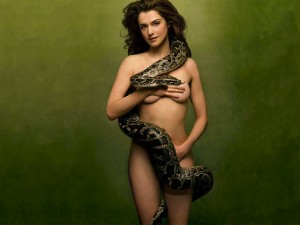3 cultural themes the SNAKE  has adopted
has adopted
(..in progress)
predator? idol? people look with mix of fear, shame, reverence
The seducer:

Michaelangelo’s, Sistine Chapel, 1509
The biblical story of Eden depicts the snake as a deceitful seducer, who tempts Eve to disobey God’s command of refraining from eating fruit from of the tree of knowledge.
God punished the snake by removing his arms and forcing him to slither on its belly. This biblical myth represents the metamorphosis of the serpent from a handsome, wise seducer, to a voiceless, limbless pathetic creature.
It turns out that Eve then lures Adam in, rendering her as a seductress as well.
This image: shows the whole story; androgynous; human like; is he limited or empowerd?
The biblical serpent in the story of Eden also is rational and manipulative, therefore he could represent wisdom, as he is able to get his way with Eve (if we interpret his banishing Adam and Eve as intentional and calculated).
The Eden myth does not specify the serpent’s specific intentions – was he acting out of pure malice? Or was he jealous of the humans and trying to evict them from Eden?
There are other stories in Genesis with slightly different depictions of snakes (as evil plagues, for example), and different versions of Genesis depict the serpent slightly differently (for example, in the Brazen Serpent myth, it is a beast / plague that bites the Israelites because of their lack of faith, and they must worship and revere this creature in order to heal).
Make thee a fiery serpent, and set it upon a pole: and it shall come to pass, that every one that is bitten, when he looketh upon it, shall live” (Numbers 21:8).
The serpent is therefore a representation of power and control, and in this myth, the people are helpless to the will of the snake.

visual discourse:
High Renaissance, Medieval theology, 16th century painting, Catholic traditions, biblical refereces, (in a sense, this painting has become kitschy and mass-produced – I’ve seen it as a poster in a college dorm room, for example…)
Fiercely Sexy

This white albino Burmese Python is fear-inducing and awe-inspiring. Yet wrapped intimately around icon Britney Spears’ neck it signifies power, seduction, and allure. This python is at once the seducer (or the object of Britney’s desire) and a representation of Britney’s inner power. She sings,
I know I may come off quiet, I may come off shy.
But I feel like talking, feel like dancing when I see this guy.
chorus: I’m a slave for you. I cannot hold it; I cannot control it.
I’m a slave for you. I won’t deny it; I’m not trying to hide it.
This phallic, muscular python represents her inner desire (the id), that she cannot “hold” or “control”. The performance represents a fight between Britney and the python, but she is also taunting the snake (she does not want to hold or control it, and she fondles its muscular body throughout the performance).
The powerful snake transforms her into nothing but a helpless slave, making this performance somewhat ironic: She is wearing this extremely strong creature, presumably boosting her own inner strength; However, she asserts that she is nothing but a slave. Is she a slave to the python? or to the subject of the song? Or is the python the subject of the song? Who is really seducing whom?
The albino Burmese python is a rare breed of snake, although the typical Burmese python is overly-prolific, and becoming an invasive species. This is because of its adaptability to multiple environments (scientists even fear that these pets-turned-pests – as people set them free – which are becoming so ubiquitous along the southeast coast of America, will make their way to New York City!) This invasive quality of this particular creature also leads to an ironic aspect, in that this species is ubiquitous and annoyingly pervasive.
The fact that the python is albino makes him a rarity, and more alluring and hard to reach. The lightness of an albino might also imply innocence its innocence? (although that might be contrived):

Visual Discourse:
pop culture, low-culture, entertainment; people rush towards her – idolize her (like Michaelangelo’s painting above)
Other female icons wearing pythons or boa constrictors:


why did the snake become such an anti hero in comic literature?
The snake is known (from my experience in America) to be foreign and exotic, as well as creepy, slimy and gross. Possibly this is because it is is both similar and dissimilar – physically – to our own human form. They are vertebrates with bilaterally symmetrical bodies, two eyes, a nose, a mouth; However, they have no arms, segmented bodies, shiny, wet-looking skin, forked tongues, bug-eyes. They just seem creepy-looking. They slither on their belly in either a wave like “S” motion or a compression / expansion type of peristalsis motion. They eat creatures that are as big as themselves, and don’t even chew. Some snakes even kill their prey by suffocation (scary). Therefore, because they are not so foreign from the human form, humans might equate themselves just enough to be repulsed by the dissimilarities that make them helpless-seeming.
Additionally, snakes are one of the few poisonous reptiles in America, rendering them into a creature that historically has taken on evil characteristics, such as being the bearer of plagues, invaders, and malicious. Therefore, Venom makes sense as Spiderman’s enemy. Spiderman represents benevolence and anti-violence. Venom, on the contrary, represents malevolence, violence, destruction, and the anti-hero.
The most creepy physical attributes are depicted in Venom’s illustrations: a long forked tongue, venom and saliva spewing out of his mouth, bug eyes, bulging veins, giant jaws, drops of slime..
visual discourse:
venomous, disease-ridden, creepy, scary, repelling; high saturation, illustrations, comic art, geared towards kids: loud, bright, full of motion, violent
More snake visual references: snakes and ladders, ungrateful: the snake parable, blue cross / staff…



